Briefly: In our opinion, no speculative positions in gold, silver and mining stocks are justified from the risk/reward point of view. We will likely have another trading opportunity shortly.
Gold soared on Friday only to slide once again before the session was over and we can say the same about mining stocks, which formed a bearish shooting star candlestick (a sign of reversal). Is gold going to soar based on its recent breakout or is it going to reverse and slide?
The latter is more likely for the medium term but the situation is rather unclear for the very short term and for the medium term. There are several developments that point to higher gold prices in the near term and there are some suggesting lower ones. Let’s take a closer look (charts courtesy of http://stockcharts.com).
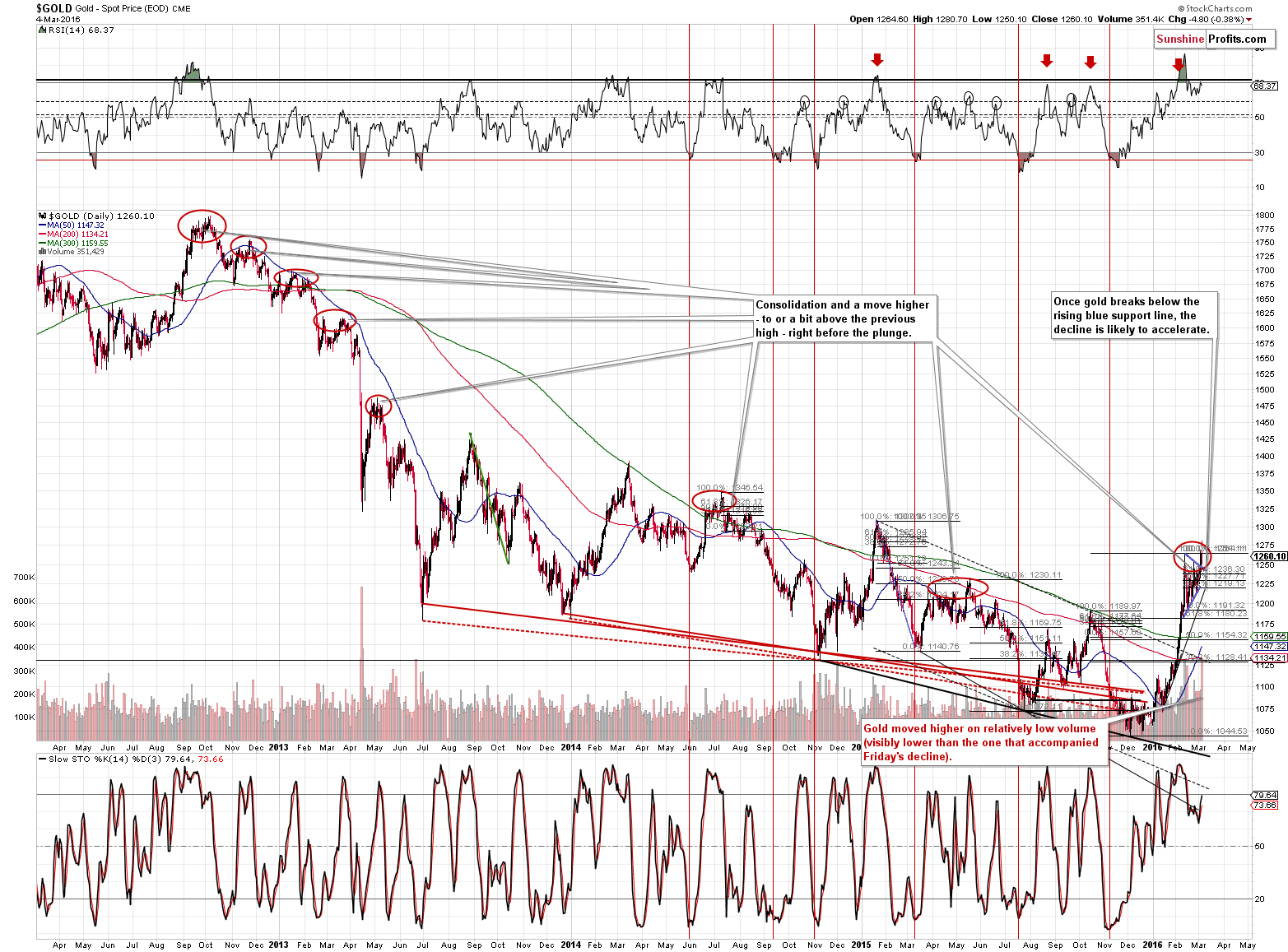
On Friday, we wrote the following:
There were quite a few cases when gold moved to or a bit above its previous local high before sliding to new lows – we marked these cases with red ellipses on the above chart. So, gold’s breakout is not a “game changer” – it’s still something that was seen right after initial tops and before major plunges. Consequently, the next big move is still likely to be down.
However, gold has broken higher (also in terms of daily closing prices) and since the move before consolidation was volatile, we can expect a volatile rally also in this case. Please note that based on the previous marked patterns, gold can reverse any day or continue to move even higher. How high?
The above remains up-to-date. Friday’s action was quite volatile as gold both soared and declined during the session. The answer to the last question can be found on the long-term chart for gold.
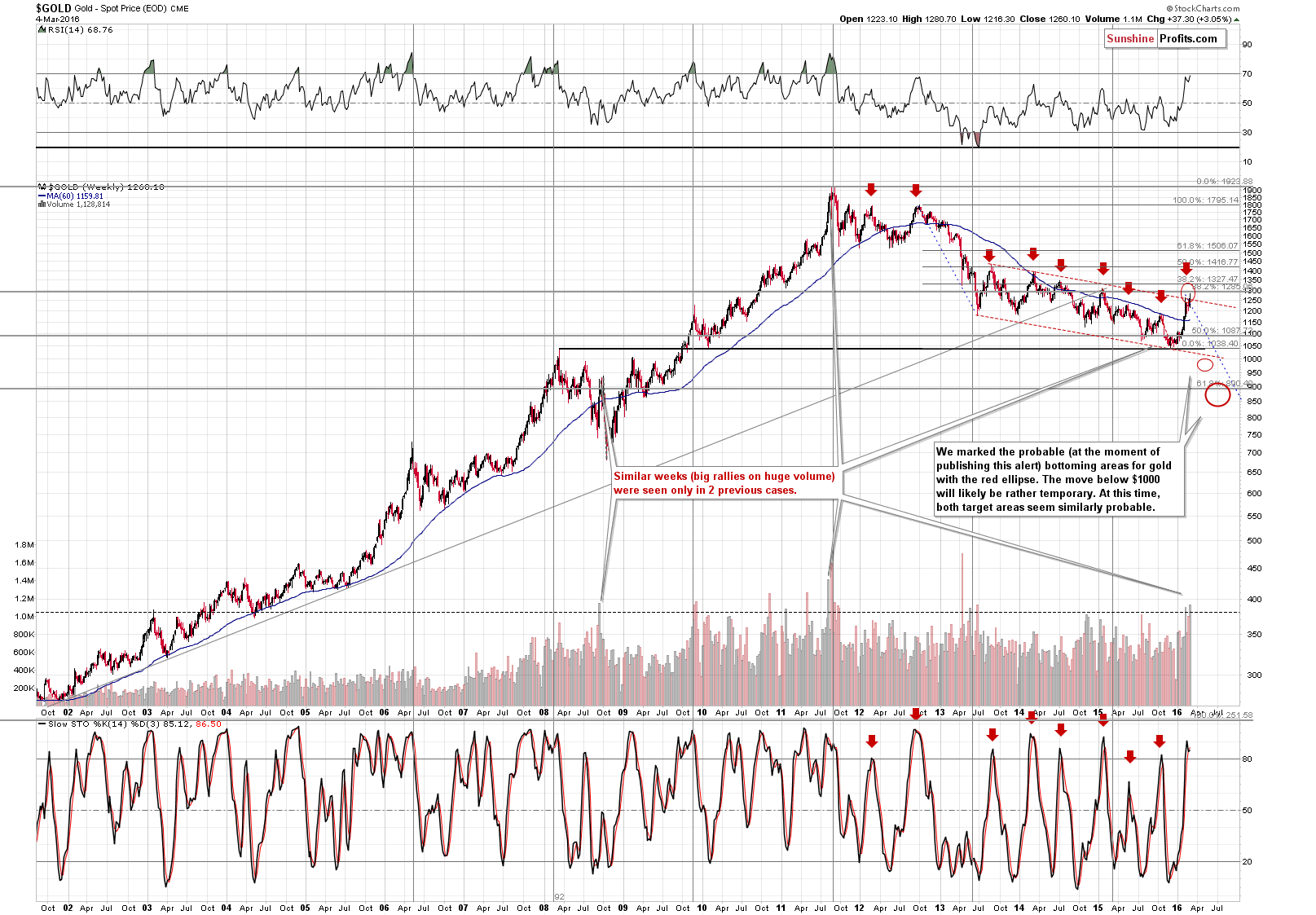
As we indicated previously, the $1,284 and $1,328 levels are the next possible targets. Gold moved to almost $1,281 on Friday, so it could be the case that the top is already in, but then again, if it is not, and gold breaks a bit above $1,300 it would still not invalidate the medium-term downtrend.
If gold had declined more on Friday, we would have a clear reversal in place, but a move of $5 lower is not enough to make the short-term outlook very bearish, especially that gold moved above the previous 2016 high in terms of weekly closing prices.
A more important bearish sign is the sell signal from the weekly Stochastic indicator. As you can see on the above chart, these signals were very reliable in the past and it seems that another big decline is just around the corner. Still, this signal doesn’t say if gold will move higher or lower in the next few days – the implications are more medium-term-oriented.
Speaking of sell signals from the Stochastic indicator, we saw an analogous signal in the case of the gold to S&P 500 ratio.
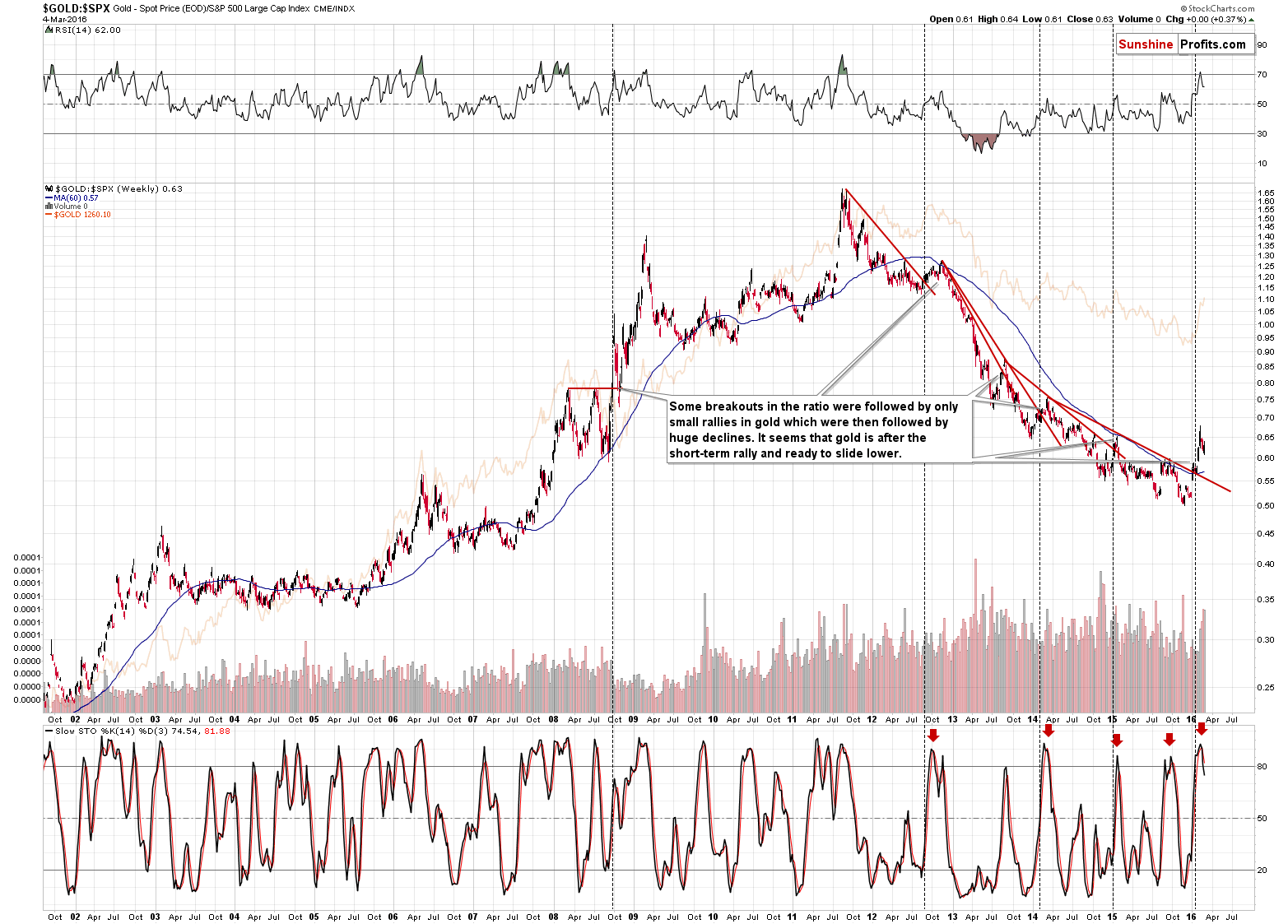
This signal also confirmed major tops in the past and the current signal is clearly visible (it’s clearer than the one in gold). The implications are bearish.
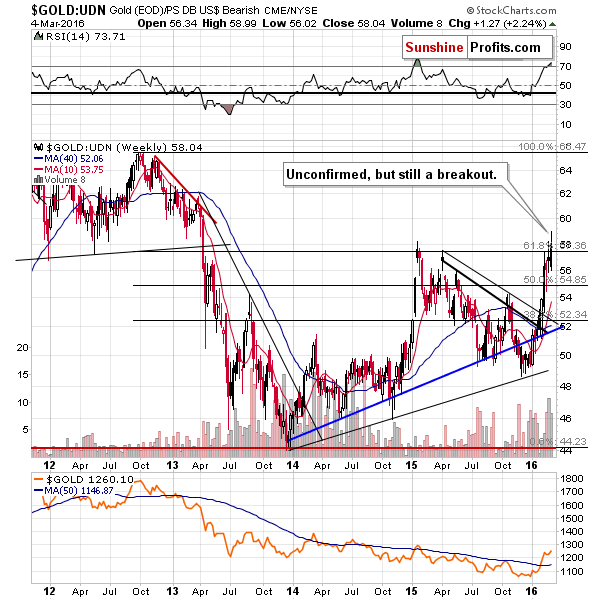
From the non-USD perspective (the average of gold prices in terms of currencies other than the US dollar), we saw a small breakout above the 2015 high. The breakout is not confirmed and its implications are only mildly bullish at this time.
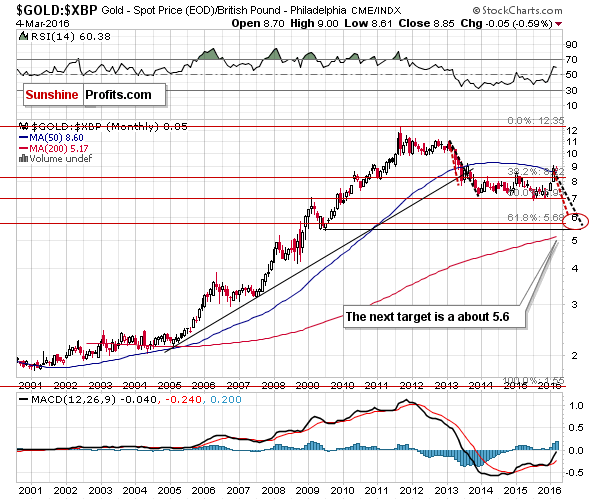
Gold priced in the British pound moved a bit lower this month and its performance is quite in tune with the previous time that it moved to its 50-moving moving average (in 2013). Back then a local top formed shortly and lower prices followed. The implications of the above chart are bearish, but not strongly so.
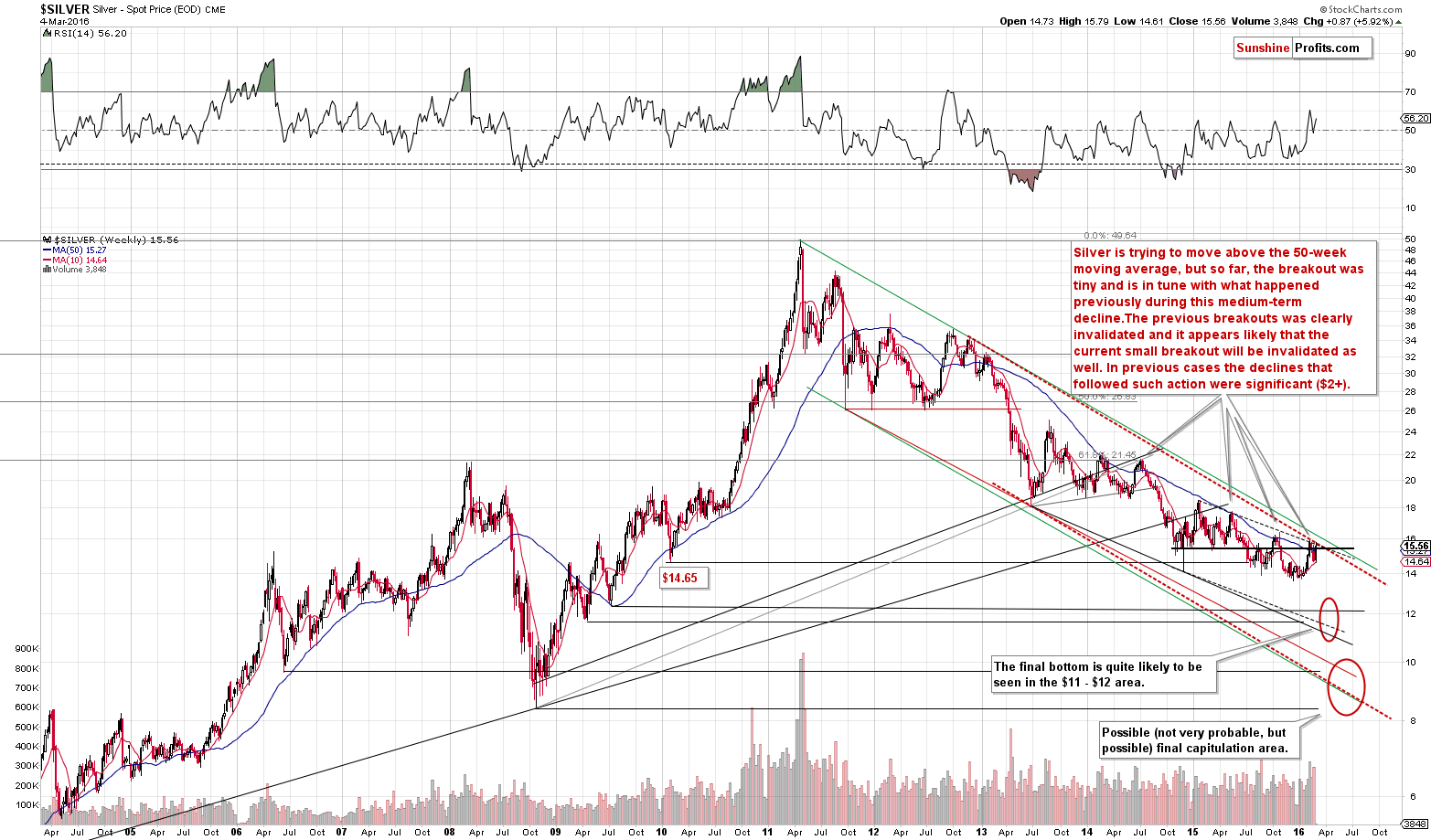
The long-term silver chart shows that the trend remains down. Silver moved a bit above the 50-week moving average, but that’s something that we saw previously and such breakouts were invalidated and followed by huge declines. Moreover, the back-and-forth movement around this moving average was also seen (twice in 2014), so just because silver is attempting to really break higher doesn’t imply anything bullish. Moreover, even if silver moved to is recent high of $16.37 or so, it would most likely not invalidate the above.
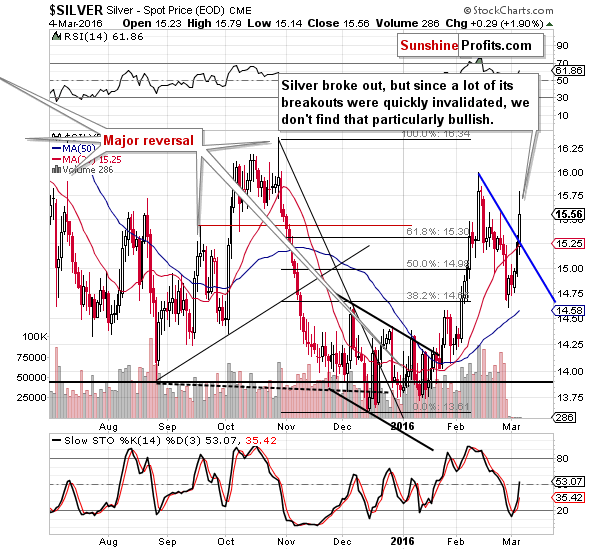
Silver moved above its declining resistance line, but silver is known for fake breakouts that are followed by sharply lower prices, so we are not viewing this upswing as a bullish sign.
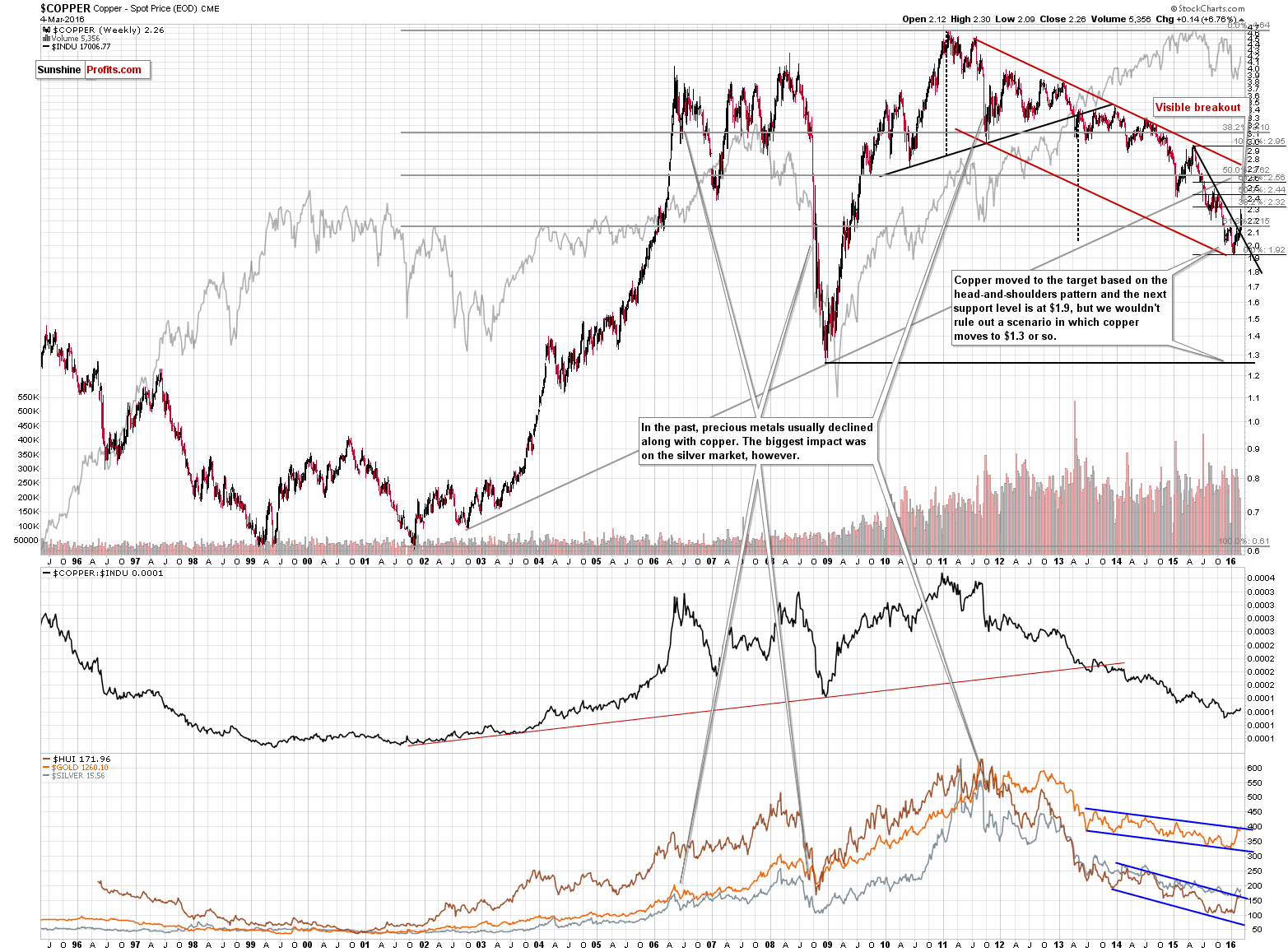
The copper price quite often moves in tune with precious metals prices, so the fact that it just broke above its declining resistance line has bullish implications. On the other hand, copper didn’t move to (let alone above it) its 38.2% Fibonacci retracement level based on the recent decline, so the days of this rally could be numbered. Overall the implications of the above chart are mildly bullish for the precious metals sector.
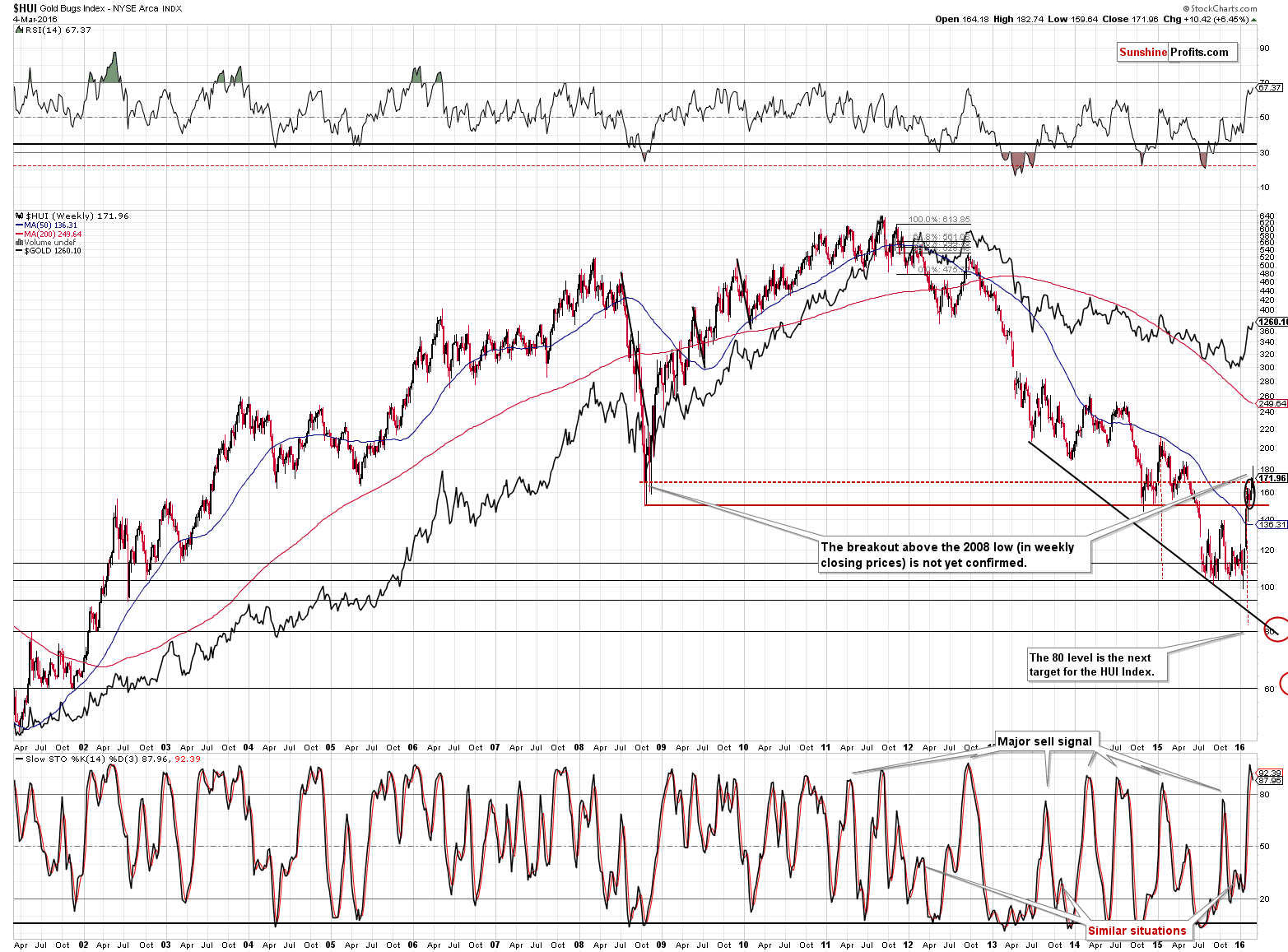
The HUI Index (proxy for gold stocks) moved higher, but the breakout above the 2008 low (in terms of weekly closing prices) was quite insignificant. Consequently, it is not confirmed and does not have important bullish implications.
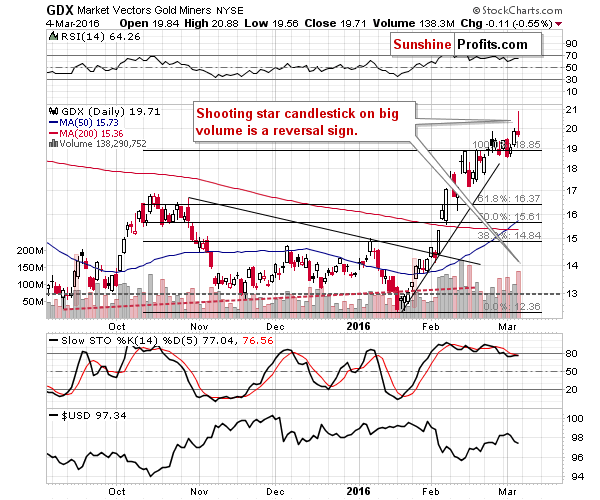
On a short-term basis, mining stocks formed a very visible reversal candlestick and it was accompanied by huge volume. The implications are very bearish for the short term. However, at the same time miners did not (yet) move below their previous highs (except the Thursday high that is), so the situation is not clearly bearish for the short term just yet.
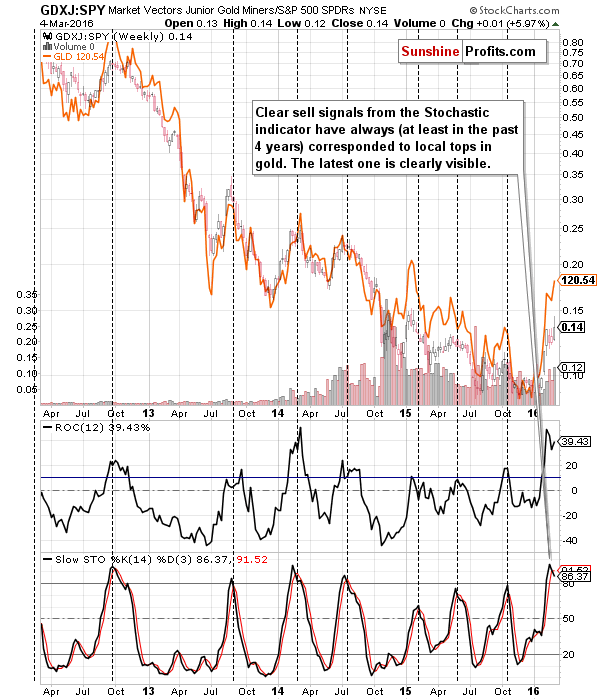
Looking at the ratio between juniors and the general stock market, we see that the Stochastic indicator flashed a major sell signal and the Rate of Change indicator is very high. The last time that we saw this combination was right before the major top that we saw in early 2014. The implications are bearish.
Summing up, quite a lot happened in metals, miners, other markets and ratios last week and the short-term outlook is now unclear as we have some signals that point to higher prices in the near term (like higher weekly closes in gold, silver and HUI) but at the same time we have a lot of bearish signs as well (reversal in miners on huge volume, sell signals from major and efficient indicators and no breakout above the previous highs in silver). Gold broke higher (in terms of both daily closing prices and in intra-day terms) and while it still appears to be topping, at this time we can’t rule out a sharp, temporary upswing to $1,328 or so. Consequently, we think that the risk to reward ratio does not favor any positions at this time. It seems that it’s justified to wait and re-enter the short position (or open a long one if we get much more bullish signs, but this doesn’t appear likely) in more favorable conditions (preferably at higher prices after seeing a major daily reversal).
As always, we will keep you – our subscribers – updated.
To summarize:
Trading capital (our opinion): No positions
Long-term capital (our opinion): No positions
Insurance capital (our opinion): Full position
Plus, you might want to read why our stop-loss orders are usually relatively far from the current price.
Please note that a full position doesn’t mean using all of the capital for a given trade. You will find details on our thoughts on gold portfolio structuring in the Key Insights section on our website.
As a reminder – “initial target price” means exactly that – an “initial” one, it’s not a price level at which we suggest closing positions. If this becomes the case (like it did in the previous trade) we will refer to these levels as levels of exit orders (exactly as we’ve done previously). Stop-loss levels, however, are naturally not “initial”, but something that, in our opinion, might be entered as an order.
Since it is impossible to synchronize target prices and stop-loss levels for all the ETFs and ETNs with the main markets that we provide these levels for (gold, silver and mining stocks – the GDX ETF), the stop-loss levels and target prices for other ETNs and ETF (among other: UGLD, DGLD, USLV, DSLV, NUGT, DUST, JNUG, JDST) are provided as supplementary, and not as “final”. This means that if a stop-loss or a target level is reached for any of the “additional instruments” (DGLD for instance), but not for the “main instrument” (gold in this case), we will view positions in both gold and DGLD as still open and the stop-loss for DGLD would have to be moved lower. On the other hand, if gold moves to a stop-loss level but DGLD doesn’t, then we will view both positions (in gold and DGLD) as closed. In other words, since it’s not possible to be 100% certain that each related instrument moves to a given level when the underlying instrument does, we can’t provide levels that would be binding. The levels that we do provide are our best estimate of the levels that will correspond to the levels in the underlying assets, but it will be the underlying assets that one will need to focus on regarding the sings pointing to closing a given position or keeping it open. We might adjust the levels in the “additional instruments” without adjusting the levels in the “main instruments”, which will simply mean that we have improved our estimation of these levels, not that we changed our outlook on the markets. We are already working on a tool that would update these levels on a daily basis for the most popular ETFs, ETNs and individual mining stocks.
Our preferred ways to invest in and to trade gold along with the reasoning can be found in the how to buy gold section. Additionally, our preferred ETFs and ETNs can be found in our Gold & Silver ETF Ranking.
As always, we'll keep you - our subscribers - updated should our views on the market change. We will continue to send out Gold & Silver Trading Alerts on each trading day and we will send additional Alerts whenever appropriate.
The trading position presented above is the netted version of positions based on subjective signals (opinion) from your Editor, and the Tools and Indicators.
As a reminder, Gold & Silver Trading Alerts are posted before or on each trading day (we usually post them before the opening bell, but we don't promise doing that each day). If there's anything urgent, we will send you an additional small alert before posting the main one.
=====
Latest Free Trading Alerts:
The U.S. economy added 242,000 jobs in February. What does it imply for the Fed policy and the gold market?
February Payrolls Report and Gold
=====
Hand-picked precious-metals-related links:
BlackRock stops issuing shares in physical gold trust, citing demand
Gold No Longer Glitters in Canada’s Official Treasure Chest
=====
In other news:
How the U.S. government inadvertently launched a $3 trillion industry.
The Treasury Market's Big Short Is in 10-Year Notes, Repos Show
Economists at global bank body warn of risks from negative interest rates
Faith in 'healing' central banks has faded: BIS
Draghi Aims ECB's Killer Blow in 11th Round Versus Deflation
Here's How Draghi Can Free Up $900 Billion of Debt for QE: Chart
Easing expectations send euro lower
Japan central bank to cut next fiscal year's growth, price estimates
Oil rout over, OPEC aims for $50 anchor, says PIRA's Ross
=====
Thank you.
Sincerely,
Przemyslaw Radomski, CFA
Founder, Editor-in-chief
Gold & Silver Trading Alerts
Forex Trading Alerts
Oil Investment Updates
Oil Trading Alerts



